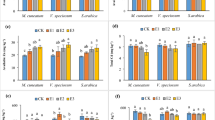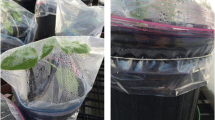Abstract
The efficiency of white lupine (Lupinus albus) to uptake and accumulate mercury from a soil polluted by mining activities was assessed in a pot experiment with chemically assisted phytoextraction. The mobilizing agents tested were ethylenediaminetetracetic acid (EDTA) and hydrochloric acid (HCl). Two doses of each amendment were used (0.5 and 1.0 g of amendment per kg of soil), and unamended pots were used as a control. Addition of HCl to the soil did not negatively affect plant biomass, while the use of EDTA led to a significant decrease in plant growth when compared to that found for non-treated pots, with plants visually showing symptoms of toxicity. The addition of hydrochloric acid increased root, shoot and total plant Hg uptake of white lupine by 3.7 times, 3.1 times and 3.5 times, respectively, in relation to non-amended plants. The greatest efficiency was obtained for the highest HCl dose. EDTA led to higher concentrations of total plant Hg than that found with the control, but, due to the aforementioned decrease in plant biomass, the Hg phytoextraction yield was not significantly increased. These results were attributed to the capability of both amendments to form stable Hg complexes. The concentration of Hg in the water of the soil pores after the phytoextraction experiment was very low for all treatments, showing that risks derived from metal leaching could be partially avoided by using doses and chemicals suitable to the concentration of metal in the soil and plant performance.



Similar content being viewed by others
References
Ali H, Khan E, Sajad MA (2013) Phytoremediation of heavy metals—concepts and applications. Chemosphere 91:869–881. doi:10.1016/j.chemosphere.2013.01.075
Bertoni GM, Pissaloux A, Morard P, Sayag DR (1992) Bicarbonate-pH relationship with iron chlorosis in white lupine. J Plant Nutr 15:1509–1518. doi:10.1080/01904169209364417
Boening DW (2000) Ecological effects, transport, and fate of mercury: a general review. Chemosphere 40:1335–1351. doi:10.1016/S0045-6535(99)00283-0
Cassina L, Tassi E, Pedron F, Petruzzelli G, Ambrosini P, Barbafieri M (2012) Using a plant hormone and a thioligand to improve phytoremediation of Hg-contaminated soil from a petrochemical plant. J Hazard Mater 231-232:36–42. doi:10.1016/j.jhazmat.2012.06.031
Clemente R, Walker DJ, Bernal MP (2005) Uptake of heavy metals and as by Brassica juncea grown in a contaminated soil in Aznalcóllar (Spain): the effect of soil amendments. Environ Pollut 138:46–58. doi:10.1016/j.envpol.2005.02.019
Eissa MA (2016) Effect of sugarcane vinasse and EDTA on cadmium phytoextraction by two saltbush plants. Environ Sci Pollut R 23:10247–10254. doi:10.1007/s11356-016-6261-9
Evangelou MWH, Ebel M, Schaeffer A (2006) Evaluation of the effect of small organic acids on phytoextraction of Cu and Pb from soil with tobacco Nicotiana tabacum. Chemosphere 63:996–1004. doi:10.1016/j.chemosphere.2005.08.042
Evangelou MWH, Ebel M, Schaeffer A (2007) Chelate assisted phytoextraction of heavy metals from soil. Effect, mechanism, toxicity, and fate of chelating agents. Chemosphere 68:989–1003. doi:10.1016/j.chemosphere.2007.01.062
Franchi E, Rolli E, Marasco R, Agazzi G, Borin S, Cosmina P, Petruzzelli G (2016) Phytoremediation of a multi contaminated soil: mercury and arsenic phytoextraction assisted by mobilizing agent and plant growth promoting bacteria. J Soils Sediments 1–13. doi:10.1007/s11368-015-1346-5
Gabriel MC, Williamson DG (2004) Principal biogeochemical factors affecting the speciation and transport of mercury through the terrestrial environment. Environ Geochem Hlth 26:421–434. doi:10.1007/s10653-004-1308-0
Gray JE, Hines ME, Higueras PL, Adatto I, Lasorsa BK (2004) Mercury speciation and microbial transformations in mine wastes, stream sediments, and surface waters at the Almadén mining district. Spain. Environ Sci Technol 38:4285–4292. doi:10.1021/es040359d
Grčman H, Vodnik D, Velikonja-Bolta S, Lestan D (2003) Ethylenediaminedissuccinate as a new chelate for environmentally safe enhanced lead phytoextraction. J Environ Qual 32:500–506
Greger M, Wang Y, Neuschütz C (2005) Absence of Hg transpiration by shoot after Hg uptake by roots of six terrestrial plant species. Environ Pollut 134:201–208. doi:10.1016/j.envpol.2004.08.007
Huang JW, Blaylock MJ, Kapulnik Y, Ensley BD (1998) Phytoremediation of uranium-contaminated soils: role of organic acids in triggering uranium hyperaccumulation in plants. Environ Sci Technol 32:2004–2008. doi:10.1021/es971027u
Kerley SJ, Huyghe C (2002) Stress-induced changes in the root architecture of white lupin (Lupinus albus) in response to pH, bicarbonate, and calcium in liquid culture. Ann Appl Bio 141:171–181
Lombi E, Zhao FJ, Dunhamm SJ, McGrath SP (2001) Phytoremediation of heavy metal-contaminated soils: natural hyperaccumulation versus chemically enhanced Phytoextraction. J Environ Qual 30:1919–1926
MAPA (Ministerio de Agricultura, Pesca y Alimentación de España) (1994) Métodos oficiales de análisis de suelos y aguas. Madrid (Spain)
Marrugo-Negrete J, Durango-Hernández J, Pinedo-Hernández J, Olivero-Verbel J, Díez S (2015) Phytoremediation of mercury-contaminated soils by Jatropha curcas. Chemosphere 127:58–63. doi:10.1016/j.chemosphere.2014.12.073
Moreno FN, Anderson CWN, Stewart RB, Robinson BH (2005a) Mercury volatilisation and phytoextraction from base-metal mine tailings. Environ Pollut 136:341–352. doi:10.1016/j.envpol.2004.11.020
Moreno FN, Anderson CWN, Stewart RB, Robinson BH, Nomura R, Ghomsher M, Meech JA (2005b) Effect of thioligands on plant-Hg accumulation and volatilisation from mercury-contaminated mine tailings. Plant Soil 275:233–246. doi:10.1007/s11104-005-1755-0
Novozamsky U, Lexmond TM, Houba VJG (1993) A single extraction procedure of soil for evaluation of uptake of some heavy metals by plants. Int J Environ An Ch 51:47–58
Rodríguez L, Rincón J, Asencio I, Rodríguez-Castellanos L (2007) Capability of selected crop plants for shoot mercury accumulation from polluted soils: phytoremediation perspectives. Int J Phytoremediat 9:1–13. doi:10.1080/15226510601139359
Römkens P, Bouwman L, Japenga J, Draaisma C (2002) Potentials and drawbacks of chelate-enhanced phytoremediation of soils. Environ Pollut 116:109–121
Schuster E (1991) The behavior of mercury in the soil with special emphasis on complexation and adsorption processes—a review of the literature. Water Air Soil Poll 56:667–680
Smolińska B (2015) Green waste compost as an amendment during induced phytoextraction of mercury-contaminated soil. Environ Sci Pollut Res 22:3528–3537. doi:10.1007/s11356-014-3601-5
Smolińska B, Cedzyńska K (2007) EDTA and urease effects on Hg accumulation by Lepidium sativum. Chemosphere 69:1388–1395. doi:10.1016/j.chemosphere.2007.05.003
Smolińska B, Król K (2012) Leaching of mercury during phytoextraction assisted by EDTA, KI and citric acid. J Chem Technol Biot 87:1360–1365. doi:10.1002/jctb.3826
Smolińska B, Leszczynska J (2015) Influence of combined use of iodide and compost on Hg accumulation by Lepidium sativum L. J Environ Manag 150:499–507. doi:10.1016/j.jenvman.2014.12.043
Smolińska B, Rowe S (2015) The potential of Lepidium sativum L. For phytoextraction of Hg-contaminated soil assisted by thiosulphate. J Soils Sediments 15:393–400. doi:10.1007/s11368-014-0997-y
Subirés-Muñoz JD, García-Rubio A, Vereda-Alonso C, Gómez-Lahoz C, Rodríguez-Maroto JM, García-Herruzo F, Paz-García JM (2011) Feasibility study of the use of different extractant agents in the remediation of a mercury contaminated soil from Almadén. Sep Purif Technol 79:151–156. doi:10.1016/j.seppur.2011.01.032
Wang Y, Greger M (2006) Use of iodide to enhance the phytoextraction of mercury-contaminated soil. Sci Total Environ 368:30–39. doi:10.1016/j.scitotenv.2005.09.034
Wang X, Shan X, Zhang S, Wen B (2004) A model for evaluation of the phytoavailability of trace elements to vegetables under the field conditions. Chemosphere 55:811–822. doi:10.1016/j.chemosphere.2003.12.003
Wang J, Feng X, Anderson CWN, Qiu G, ** L, Bao Z (2011) Ammonium thiosulphate enhanced phytoextraction from mercury contaminated soil—results from a greenhouse study. J Hazard Mater 186:119–127. doi:10.1016/j.jhazmat.2010.10.097
Wang J, Feng X, Anderson CWN, **ng Y, Shang L (2012) Remediation of mercury contaminated sites—a review. J Hazard Mater 221-222:1–18. doi:10.1016/j.jhazmat.2012.04.035
Xu J, Bravo AG, Lagerkvist A, Bertilsson S, Sjöblom R, Kumpiene J (2015) Sources and remediation techniques for mercury contaminated soil. Environ Int 74:42–53. doi:10.1016/j.envint.2014.09.007
Zornoza P, Millán R, Sierra MJ, Seco A, Esteban E (2010) Efficiency of white lupin in the removal of mercury from contaminated soils: soil and hydroponic experiments. J Environ Sci 22:421–427. doi:10.1016/S1001-0742(09)60124-8
Author information
Authors and Affiliations
Corresponding author
Additional information
Responsible editor: Elena Maestri
Rights and permissions
About this article
Cite this article
Rodríguez, L., Alonso-Azcárate, J., Villaseñor, J. et al. EDTA and hydrochloric acid effects on mercury accumulation by Lupinus albus . Environ Sci Pollut Res 23, 24739–24748 (2016). https://doi.org/10.1007/s11356-016-7680-3
Received:
Accepted:
Published:
Issue Date:
DOI: https://doi.org/10.1007/s11356-016-7680-3




